What is Energy Psychology?
What is Energy psychology (EP)? It is a set of somatic, holistically influenced, evidence-based tools and therapeutic interventions that help people manage their mental health issues. One of the most popular forms of EP is EFT, the Emotional Freedom Techniques. EFT and other EP methods are gaining traction because they provide therapists and clients effective alternative to traditional talk therapy. They are particularly effective in helping people heal from underlying traumas. They also empower clients, as these tools and skills can be taken out of the treatment room and used in regular self-care and emotion regulation practices. These practices have stood the test of time, only gaining in popularity and clinical application. Most importantly, they help people. Here are four ideas that will help you understand EP.
Trauma gets locked in the body. EP involves the body.
EP involves the body, and we increasingly understand how important that is in addressing difficult emotional issues, particularly trauma. Bessel Van der Kolk’s book The Body Keeps the Score tells the story: When we experience trauma, that trauma seems to get “locked” in our bodies. When we experience PTSD, our brains light up as if we were experiencing the trauma all over again. Our bodies go into fight-flight-freeze mode instantly. People might know that the trauma is in the past, but it feels like it’s in the present. Talk therapy can go on, providing a lot of insight, but – to the dismay and frustration of clinicians and clients – it doesn’t move the needle on trauma responses. We can’t think our way out of trauma.
Body-based practices like most EP techniques are particularly effective at healing trauma. Trauma is a huge issue in mental health. And it’s not just about wars and car accidents. All kinds of life experiences can be traumatic, including loss, being diagnosed with a serious disease, and being in a dysfunctional relationship. Childhood traumas leave lasting impacts, as we now understand. The ACE study shows just how powerful the effects of childhood trauma can be. All kinds of trauma underlie many other mental health issues, including addictions. EP offers tools that help address the trauma and mitigate the damage.
EP has a strong and growing research base.
Of more than 400 therapeutic approaches, EP is in the top 10 in terms of research base. Studies show it is effective for anxiety, PTSD, depression, weight loss, and a host of other issues. I recently introduced EP to a group of people with breast cancer and told them about a study of 212 cancer patients who decreased their chemo brain after eight weeks of tapping. They were enthusiastic about giving EP a try.
That’s just one small example of EP research. To date, more than 200 articles about energy psychology published in peer-reviewed journals demonstrate its effectiveness. Among these are more than 115 studies: 99% of the studies document efficacy for energy psychology modalities. These include more than 50 pre-post studies and 65 randomized controlled studies. The body of research includes 12 systematic reviews. and five meta-analyses of energy psychology therapies. The data show EP is effective for pain, depression, anxiety, trauma and PTSD, and other issues.
These techniques have been around for more than 30 years.
Roger Callahan was the first known American psychologist to incorporate meridian tapping in his work, beginning in the 1990s. The results his clients achieved were impressive -- and exciting! He found long-held issues were clearing up in ways he had never experienced. Callahan began teaching other psychologists how to apply his method. He created the first manualized meridian-based therapy, Thought Field Therapy (TFT). One of his students was Gary Craig, who went on to found EFT. Other tapping protocols have been developed, studied, and used widely – as self-help tools, in clinical treatment settings, and around the world in disaster response missions.
Thousands of people in the US and around the world have been using EP methods for many kinds of issues from depression and anxiety to trauma and PTSD to weight loss and chemo brain. EFT, in particular, has become very popular in the self-help world: in 2016, half a million people participated in Nick Ortner’s free, online Tapping Summit. EP has made tremendous inroads in the clinical setting: more than 10,000 clinicians have been trained by the Association of Comprehensive Energy Psychology (ACEP), and that is just one organization dedicated to teaching clinical EP skills.
Most importantly, EP helps people.
I have used EP in my clinical practice for the past decade and I have seen amazing things. Just like Callahan saw 3 decades ago, I have witnessed people become free from their traumatic experiences. It often happens in just one session. Moreover, the results last.
In my facilitated support groups for women with breast cancer we often incorporate EFT tapping at the start of our sessions. Recently, two of the women started crying almost immediately. The tears faded quickly. After 15 minutes of tapping, they were replaced by calm smiles. One of the crying women said that hers had been tears of relief as she was able to voice the deep emotional pain she had been suffering. The other said that she simply felt calm after tapping. They all said they felt better than they had in a long time.
One of my favorite stories is from a colleague in Ohio, Robin Trainor. Robin met a woman at a retreat several years ago. The woman said she had been gang raped 10 years before. She was haunted by the trauma, couldn’t forgive, and said it was ruining her life. Robin did EFT with her. The woman was 10-out-of-10 upset at the beginning, but after 45 minutes of tapping, her distress went to zero. A year later, she was still free of the trauma.
If you chat with an EP practitioner, you will hear stories like these. People get better fast when they involve the body in their therapy, and EP tools do just that. If it sounds too good to be true, it isn’t. It is what we need to be doing more of in order to help people.
Biofield therapy for cancer: the impact of healing on stress and disease
- A study shows how biofield therapy affects physiological and psychological markers of stress; this blog explains it.
My recent blog about Reiki for cancer patients generated a lot of interest. Today’s post takes a deeper dive into the research. Here we examine one study, a dissertation by Shamini Jain which was published in 2009. In this study, Jain compared biofield therapy to mock healing for breast cancer patients, examining various psychological measures as well as markers of inflammation. Results showed that biofield healing provided significant improvements compared to the mock healing protocol.
Study background
The participants in the study had been treated for breast cancer, which affects millions of women around the world. The stress of a cancer diagnosis can linger long after treatment has been completed, placing cancer survivors at a greater risk for depression and fatigue, which in turn reduces their quality of life. Frustratingly, it even increases the chances of disease recurrence. Clearly, we need effective tools to combat this distress.
Jain’s study helps us to understand the cycle of stress – inflammation – disease, and offers hope that biofield therapies, which are popular among breast cancer patients, are more than just feel-good practices. The study found a reduction in psychological distress and inflammatory markers in the short term and raises the hope that these practices might lead to better outcomes in the long-term.
How inflammation leads to disease: a microscopic story
To understand this study, it’s important to understand how chronic stress can lead to inflammation and disease. Here’s a short explanation:
HPA axis:
The hypothalamus-pituitary-adrenal (HPA) axis is our bodies’ stress response system, a cycle of neural and chemical responses to threat. The hypothalamus, in the brain’s limbic system, cues the pituitary to release a hormone called ACTH (adrenocorticotropic hormone). ACTH races to the adrenal glands, signaling them to release cortisol. Cortisol pours into our bloodstream, causing our hearts to beat faster, blood pressure to rise, and blood sugar levels to increase. We are not digesting food well or fighting pathogenic invaders; we are ready to fight or run away. When faced with an imminent threat, this is exactly what we need.
Inflammation:
The HPA axis and cortisol response also work with our bodies’ inflammatory and anti-inflammatory chemical messengers, called cytokines. When we have an injury or infection, our cells release inflammatory cytokines. These molecules cause cells to fill with more fluid and call on our immune system cells to rush to the affected area. When the crisis has abated, a different set of cytokines, the anti-inflammatory ones, come to the area and reverse the response. Inflammation decreases, and cellular function returns to normal. This works to create an efficient response to a real threat – or a dysregulated system that leaves us open to disease.
Chronic inflammation:
When we are under continual stress, our body chemistry gets out of balance. This affects us at the epigenetic level and can cause problems with RNA (ribonucleic acid) protein synthesis. The epigenome is the covering of our DNA that turns on, or off, the expression of genes. RNA are the molecules that replicate portions of our DNA to create the proteins we need for regular cellular activities like cell metabolism and replication. Sometimes the replication goes wrong, and the proteins are incorrectly synthesized, leading to issues like cancer. Thus, in cases of chronic inflammation, dysfunctions in DNA, the epigenome, and RNA errors all may play a role in creating disease.
Stress:
Our mental state is certainly a factor in the stress – inflammation – disease cycle. Depression, fatigue, and chronic stress contribute to cellular dysfunction and increase the chances of developing disease. But what can happen if we de-stress? Studies about the benefits of biofield therapy have already shown that these treatments can help ease our fatigue, anxiety, and depression. Do they also change our body chemistry? In this study, Jain sought to determine if energy healing would provide significant relief from the psychological issues of fatigue, depression, and mood disturbance, as well as a physiological decrease in chemical markers of inflammation and cortisol levels.
The study setup
Jain recruited breast cancer survivors near the University of California, San Diego. For this randomized, placebo-controlled study, some participants received an energy healing technique (EH) and others received mock healing, twice a week for four weeks.
Healing protocol:
Energy Healing (EH) used is similar to forms you may be familiar with, like Reiki, Healing Touch, and Therapeutic Touch. In EH, the practitioner balances their own energy with energy from the universal energy field, then uses a series of hand positions on the patient (feet, knees, hips, bladder, stomach, hands, elbows, shoulders, heart, throat, head, and heart again). The process takes 45-60 minutes. The healers in this study had completed a four-year training in EH and had several years of experience. The mock healers were skeptical or naïve to energy healing.
Participants:
29 women completed the study, 16 in the EH arm and 13 in the mock healing arm. All were adults who had been diagnosed with stage 1 to 3a breast cancer and had completed treatment (surgery, radiation, and/or chemotherapy) within the previous five years and at minimum, a month before the study began.
Psychological measures:
In addition to a demographic questionnaire, participants completed a standard set of psychological assessments, including measures to assess fatigue, depression, mood (including depression, anxiety, anger, vigor, fatigue, and confusion), quality of life, and sleep.
Physiological measures:
Researchers measured markers of inflammation over the eight treatment sessions and at follow-up. These included cortisol and various cytokines associated with breast cancer. These included:
- Interleukin-1 soluble receptor (sIL-1Ra): This is an analog of the inflammatory cytokine interleukin 1 (IL-1), which is found in breast tissue, is associated with fatigue, has been shown to increase in people with depression; its presence is associated with disease progression. sIL-1Ra is easier to measure than IL-1. It was studied as a marker of fatigue and depression.
- Interleukin 6 (IL 6): IL-6 is a proinflammatory cytokine that is associated with breast cancer; higher levels are present in people with breast cancer compared to healthy controls. Increased levels of IL-6 are associated with stage, grade, metastasis, and chemotherapy resistance; it may be particularly relevant in estrogen-positive cancers. It is higher in patients with depression and was studied as a marker of fatigue and depression.
- Interleukin-6 soluble receptor (sIL-6R): This is a receptor for IL-6 and is highly associated with fatigue in breast cancer patients. It was studied as a marker for fatigue and depression.
- Soluble Tumor Necrosis Factor Receptor II (sTNF-RII): This is an easier-to-measure receptor for Tumor Necrosis Factor alpha (TNF-α). TNF-α is an inflammatory cytokine that is associated with both tumor death (as the name suggests) and, paradoxically, tumor growth and metastasis. Its receptor sTNF-RII levels seem elevated in fatigued compared to non-fatigued breast cancer survivors. It was studied as a marker of fatigue.
- Interleukin-4 (IL-4): While IL-4 is considered an anti-inflammatory marker, it is associated with resistance to chemotherapy and apoptosis (cell death). It was studied as a biomarker of fatigue.
- Cortisol, and Diurnal Cortisol Variability: Cortisol is particularly relevant for people with breast cancer. In a healthy population, cortisol levels drop at night. In breast cancer patients, cortisol levels are generally higher, have more fluctuations during the day, and do not drop as low at night. Among breast cancer patients with fatigue, these differences are even more pronounced. Thus, mean cortisol as well as nighttime drops in cortisol were measured.
Study results
Most participants – 75% – believed they were receiving the actual energy healing, 87% in the healing group and 72% in the mock group. This was important to assess for exploring the role of expectancy on results. The differences between groups over time showed the EH group overall received better results than the mock group:
Psychological measures:
On most psychological measures, the EH group did better on measures of fatigue, depression, and mood than the mock group (all but sleep, where neither group improved). The mock group’s scores on depression deteriorated over time. Below are the details:
- Fatigue (MFSI-sf): Radiation was associated with fatigue; time since radiation completed was associated with lower fatigue scores at baseline. Overall, the EH group experienced a greater drop in fatigue over time than the mock group (p = .09, partial eta square = .13 with time since radiation as a covariant; p = 0005, partial eta square = .30 with no covariant).
- Depression (CESD): The EH group decreased in depression over time, while the mock group actually increased in depression (p = .22, partial eta square = .24).
- Mood (POMS-sf): Women who had received chemotherapy had more mood disturbance at baseline. Both groups showed a large decrease in mood disturbance over time (p = .001, partial eta squared = .25).
- Quality of life (FACT-B): Women who had received chemotherapy had a lower quality of life at baseline. Both groups increased in quality of life over time. The belief that they were getting EH predicted improvement in quality of life (p = .037).
- Sleep (PSQI): Older women had poorer sleep at baseline. The treatments had no effect on sleep.
Physiological measures:
While the groups saw roughly equivalent results on one measure (Tumor Necrosis Factor Receptor II, TNFRII), the EH group improved more than the mock group on all other measures. The mock group saw some increases in inflammatory biomarkers over time. Zooming in:
- sIL-1Ra: There was a large effect size, with the mock group experiencing an increase in this biomarker over time, while the markers decreased in the EH group (p = .048; partial eta square = .21))
- IL-6: A large effect size was found, with the biomarker in the mock group increasing while that in the treatment group decreased over time (p = .06, partial eta square = .19)
- sIL-6R: Both groups improved but the EH group saw a greater decrease in this biomarker (p = .02, partial eta square = .32).
- IL-4: The mock group saw a slight increase over time while the EH group saw a significant drop (p = .05, partial eta square = .21)
- TNFRII: There were no differences between groups; both decreased slightly over time.
- Cortisol slope: Both groups ended with a drop in cortisol, but the mock group experienced an increase at midway, and the EH group experienced a steeper drop.
- Mean cortisol: Mean cortisol in the mock group increased while it dropped in the EH group.
Why this study matters: biofield therapy helps people who have had cancer
This study examined the effects of a biofield therapy on both psychological distress and physiological bio-markers associated with inflammation and disease progress in breast cancer patients. It shows that the biofield therapy studied, EH, decreases these biomarkers over time, while improving fatigue and mood issues that are associated with disease progression. This adds to the growing body of evidence supporting biofield therapies, which are already popular among breast cancer patients, showing that these may be more than feel-good therapies. Because of their effects on both psychological and physiological markers of inflammation and disease, these therapies seem to affect us at the molecular level in ways that might slow cancer growth as they promote wellbeing.
Looking ahead
Every year in the US, nearly 300,000 women are diagnosed with breast cancer. Almost 3.8 million American women are living with breast cancer. A woman’s chance of being diagnosed with invasive breast cancer is 1 in 8. And while early detection and treatment are making a dent in prognosis, mortality has dropped by less than 3%. Alongside the rigorous medical research, we have a growing understanding of the mind-body correlates of disease and the cycle of stress-inflammation-disease. This offers us a new hope, and a new tool to add in our approach to fighting cancer. As the research in mind-body therapies continues, pharmaceutical companies, oncologists, and the medical establishment are increasingly open to using these as adjuvant therapies. Patients themselves are eager to take advantage of these therapies to improve outcomes while we wait and hope for the cure.
I often envision a time, perhaps not too far in the future, in which healing professionals will work alongside doctors and nurses to offer energy healing to patients in need. I dream of a day when societies will prioritize the emotional wellbeing of their citizens. As a therapist, I earnestly wish for people to treat each other well, with lovingkindness, erasing the disharmony that underlies so much of today’s stress. Today, we are already moving in that direction, by employing mind-body tools to address these stressors – tools like energy psychology, energy medicine, and energy healing, in all their various forms. Because of these results, these techniques increasingly play a role in easing the stress-inflammation-disease cycle.
The Field of Energy Psychology
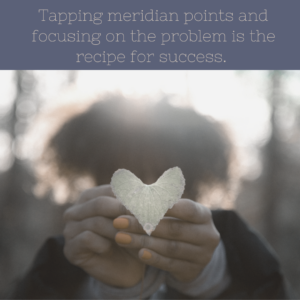 I have used EFT and other meridian tapping therapies both for myself and with many clients in my therapy practice. I have seen issues―even really tough ones―clear up quickly, almost magically. These results intrigued me, and prompted me to do some research about the field of Energy Psychology; you can read some of it here. People sometimes wonder if tapping meridian points is really a necessary ingredient to EFT's success. One particularly bright and educated client of mine said that he believed it was exposure (the repeated statement of the problem) coupled with a self-soothing technique (tapping) that helped people get clear of their issues. He is a psychologist, so he thinks about these things. The topic has been widely debated, and he is not alone in his suspicions. And the research shows that―he's wrong. Here's the deal with EFT tapping.
I have used EFT and other meridian tapping therapies both for myself and with many clients in my therapy practice. I have seen issues―even really tough ones―clear up quickly, almost magically. These results intrigued me, and prompted me to do some research about the field of Energy Psychology; you can read some of it here. People sometimes wonder if tapping meridian points is really a necessary ingredient to EFT's success. One particularly bright and educated client of mine said that he believed it was exposure (the repeated statement of the problem) coupled with a self-soothing technique (tapping) that helped people get clear of their issues. He is a psychologist, so he thinks about these things. The topic has been widely debated, and he is not alone in his suspicions. And the research shows that―he's wrong. Here's the deal with EFT tapping.
EFT researchers have begun conducting "dismantling studies" to separate tapping from the cognitive and exposed portions of the protocol. The first study that attempted to parse out the components of EFT's success were (EFT skeptics) Waite and Holder. In 2003, they conducted a study comparing three tapping conditions (EFT, sham points, and a doll) to a non-tapping condition. However, they mistakenly used EFT points, because they asked participants to with their fingertips, which contain meridian points. Participants in all three tapping groups showed significant improvements; the non-tapping group did not. Waite and Holder concluded that EFT owed its success to distraction and desensitization. But they failed to take the fingertip meridian points into consideration when they reached this conclusion. Perhaps because of this, their study is an outlier when compared to other EFT studies.
In 2013, Louis Fox conducted a study to parse out the components of EFT's success. He compared EFT to a control group that used the cognitive and exposure portions of EFT with mindful breathing instead of tapping. The group that used EFT tapping points did significantly better than the control group. In 2014, Rachel Rogers and Sharon Sears conducted a similar study but in this case, the control group used sham tapping points. Again, the group that used the actual EFT tapping points had significantly better results. The most recent dismantling study was conducted in 2015 by Reynolds, who also compared EFT to a group using sham tapping. And again, the EFT group had better results than the control group. (See this study in the Energy Psychology Journal)
The research bears out again and again what EFT practitioners and enthusiasts have intuited for more than a decade. Tapping meridian points and focusing on the problem is the recipe for success. EFT has helped thousands of people overcome a variety of emotional issues. If you would like to learn more about it, I highly recommend EFT creator Gary Craig's website, along with the Association of Comprehensive Energy Psychology's.
To hear more about Energy Psychology, be sure to join my mailing list.
Signs That Point Us Along Our Way
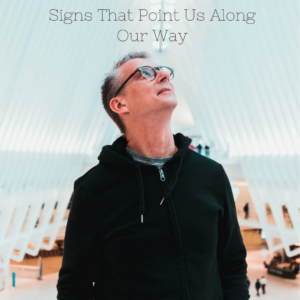 I had been thinking of going to graduate school but I was afraid. It would cost money and time that I was not sure I had to invest. It seemed like I already had a lot on my plate as a single mom of three young kids. And it had been a while since I’d done the school thing. I graduated from college thirteen years earlier, and had taken some more undergraduate classes since then, but it had been years since I was in a classroom. Formal graduate education was daunting.
I had been thinking of going to graduate school but I was afraid. It would cost money and time that I was not sure I had to invest. It seemed like I already had a lot on my plate as a single mom of three young kids. And it had been a while since I’d done the school thing. I graduated from college thirteen years earlier, and had taken some more undergraduate classes since then, but it had been years since I was in a classroom. Formal graduate education was daunting.
However, I didn’t have another plan. I was teaching yoga and had been studying Reiki. I had considered learning massage and trying to earn a living as a massage therapist/Reiki practitioner/yoga teacher. But I had another thought—that maybe I should get a master’s degree in counseling and become a therapist.
I was on the mailing list of Immaculata University, which is a beautiful school close to where I live. Earlier in the summer, I had attended a yoga teacher training, and one afternoon I decided to dedicate my practice to getting clarity on the grad-school issue. At the end of class, I had my answer: go to grad school. I stood in front of dozens of my fellow students and shared what I had received. But then I went home and chickened out. Instead of registering for classes, I continued spinning in fear and doubt.
At the end of the summer, I went to the beach for a vacation. Early in the week, I headed to the water’s edge to do a surf-side meditation to get clarity on this issue (again!). I sat down, closed my eyes, and asked for a sign. I heard one of those advertising airplanes overhead, and thought “No, I’m not going to look—I’m doing meditation.” But I couldn’t help it. My eyes opened up and I saw the banner: Immaculata University. No kidding, though I did laugh. I packed up my chair, went back to the house, went online, and signed up for a class right away.
My story was a legend at school. I heard that they’d only flown the banner once or twice that summer, and we laughed that clearly, it was for me and that with my tuition fees, it did indeed pay for itself! One of my teachers wondered how many people in the same situation would have not looked up, or not noticed, or not heeded the “coincidence”.
Sixteen later I can say without a doubt: I’m glad I did. And I am certain that, even if they are not always literal signs, we DO receive signs that point us along our way. Once we accept that these signs exist, staying calm and centered to the best of our ability helps us begin to notice them. And they carry the constant reminder: We are never alone.
What signs have pointed you along your way? Post in the comment section.
Release a past-life trauma
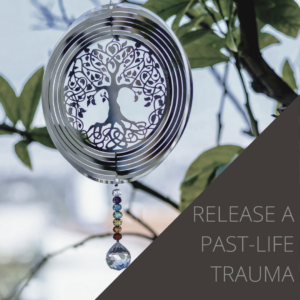 I have seen and experienced incredible healing through past-life regression therapy over the years―on both sides of the recliner, so to speak. In my therapy practice, I have helped clients resolve longstanding issues through regression therapy. As a client, I have used regression to gain insight and heal the patterns that kept me from thriving and to shine light on things that made no sense from my logical mind’s point of view. Regression therapy is one of the very best tools we have for making strides―big strides―in personal growth.
I have seen and experienced incredible healing through past-life regression therapy over the years―on both sides of the recliner, so to speak. In my therapy practice, I have helped clients resolve longstanding issues through regression therapy. As a client, I have used regression to gain insight and heal the patterns that kept me from thriving and to shine light on things that made no sense from my logical mind’s point of view. Regression therapy is one of the very best tools we have for making strides―big strides―in personal growth.
One of my most interesting experiences happened when I was in graduate school. I have not been afraid to speak in front of groups since I was in middle school; in graduate school, I gave many presentations without a hitch. I went on to become a professor at the local community college. I’ve given talks at corporations, taught yoga classes, led meditations….you get the point. But one time in grad school was very different.
As the final project for my human development class, I had to give a five-minute talk about “anything related to human development”. I chose to talk about the chakras. It went well, and I received a high A for my effort. But I felt sick. After class, I went to meet my boyfriend at the park so we could run together. When I got to the parking lot, I opened my car door and got sick on the asphalt. So much for our run.
A few days later, I met with my hypnotherapist to figure out what had gone wrong. We did a regression therapy and uncovered a lifetime in which I had been stoned to death for having religious views that differed from the prevailing norm. I think that the lifetime was during the very early Christian era, and that I was a Gnostic Christian. The specifics of the case are interesting but far less important than what happened next. What happened next was the healing.
My hypnotherapist and I did healing on this memory. We connected to the after-death experience to reinforce the knowing that death really isn’t bad, and my Higher Self nurtured, loved, and protected that unfortunate me. Eventually that other “me” felt brave and calm and almost regal, and totally unafraid to speak her truth.
And now I’m writing a public blog post about past-lives, hypnotic regression, and metaphysics.
What would you do if you could release a past-life trauma? Comment in the chat.
How to Commit to a Daily Meditation Practice
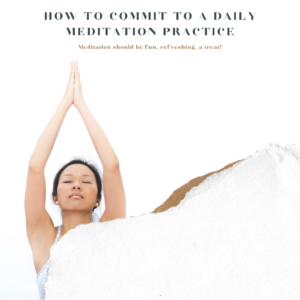 We know we "should" meditate--tons of physical, emotional, and mental benefits have been documented. We can lower blood pressure and cardiovascular health, improve outcomes for a host of medical treatments, relieve depression and anxiety, improve concentration and mental function, and more and more...but somehow we just can't seem to commit to the practice. Disciplined in so many other areas, why are we blocked from the discipline of meditation? We know we can benefit from as little as 10 minutes. The question remains: how to commit to meditating?
We know we "should" meditate--tons of physical, emotional, and mental benefits have been documented. We can lower blood pressure and cardiovascular health, improve outcomes for a host of medical treatments, relieve depression and anxiety, improve concentration and mental function, and more and more...but somehow we just can't seem to commit to the practice. Disciplined in so many other areas, why are we blocked from the discipline of meditation? We know we can benefit from as little as 10 minutes. The question remains: how to commit to meditating?
Our egos like to be busy and they like to be in control. In order to maintain that (illusion of) control, the ego can set up a lot of roadblocks to keep us from meditating. Here are some of the common strategies our egos use and some ways to counter them:
- Our egos love to tell us that we are too busy to meditate. Of course, that is not true. There is an old saying that goes: "Meditate every day for an hour unless you are too busy. In that case, meditate for two hours." There is a lot of truth to this, but an ego that thinks it is too busy probably won't agree to that! So we can set an expectation that our ego will agree to. We can achieve a lot in just five to ten minutes of meditation, and even the most stubborn egos will have a hard time arguing with that!
- Our egos often tell us that meditation is something specific that we "can't do". The inner dialogue goes something like "Meditation is not thinking; I can't not-think!" or "Meditation is reciting a weird mantra, and I don't want to do that!", or "Meditation means sitting cross-legged, and my legs can't cross like that!", or "Meditation means counting the breath; I'll feel like I'm suffocating!" Meditation can be any of these things and it can be something else. We can do a little research and find a style that seems reasonable to us.
- Sometimes our egos tell us that we can't meditate because we can't stop thinking. When my ego tried that one, I made a deal with it: I sat in meditation but let my mind process its ideas, go through the list of chores, think about the grocery list. This became "thinking time before meditation". I decided to be OK with it, and have come to think of it as a kind of clearing process. Many of my meditation friends do the same thing. As it turns out, our minds come up with some good stuff when we give them the time to process. After the processing time, we can move on to our meditation.
- In other cases, our ego puts us to sleep. When this happens, it is a good idea to make sure we keep our meditation time short and our posture pretty straight and not comfy-cozy. The ego trick of falling asleep is something that patience and persistence will help us through. For me, it was kind of like training my toddlers to not throw tantrums: I didn't cave in to candy in the grocery store, and I didn't give my own ego what it wanted, either―I sat in meditation anyway.
- Our egos can get trapped in other kinds of rigid thinking that keep us from meditating. It is best to meditate first thing in the morning, but I am not a morning person. When I had to wake early and was off to a busy start, I meditated at night instead. Now my schedule has changed so I do my meditation in the morning most of the time.
Meditation should be fun, refreshing, a treat! As we become aware of the good vibes we get when we meditate, those feelings in themselves can become the positive reinforcement that keeps us going. Till then, the tricks listed above can help answer that question, how to commit to meditating!
Join me for my meditations each Monday at 12:15pm ET on FB Live.
A Resolution to Be Happier
 As you are thinking about your goals for this New Year, have you considered adding “be happy!” to the top of your list? Perhaps you should. There has been a lot of talk about happiness recently, and researchers are finding out about the many benefits to happiness-besides just feeling, well, happy.
As you are thinking about your goals for this New Year, have you considered adding “be happy!” to the top of your list? Perhaps you should. There has been a lot of talk about happiness recently, and researchers are finding out about the many benefits to happiness-besides just feeling, well, happy.
Happy people are also healthier, more successful, and have better relationships and greater job satisfaction. The pursuit of empty pleasure does not make for a happy life. Happiness comes from a blend of a positive outlook with meaning in life. Here are some mindset changes that can help increase your happiness:
- Adopt a “glass-is-half-full” attitude. There is plenty wrong in the world, for sure, and nobody’s life is easy. But focusing on the negatives breeds discontent. Instead, focus on what is right--and see it grow.
- Don’t compare. No matter how tempting it is when you pass a Ferrari, a mac-fabulous house, or a person with a rockin’ bod, don’t compare your life to anyone else’s. You are on your own journey, learning the things you need to become the person you are becoming. You can’t really know what anyone else is going through but you can be sure of one thing: We all have pain. It’s part of the human experience.
- Be mindful of your words. Words have power and we should use them wisely. Make it a practice to avoid hurtful words. One all-too-popular form of hurtful speech is gossip, which is like a boomerang: you won’t avoid being hurt by it if you engage in it. We can also fall into the trap of hurtful speech during conflict. Instead, use your words carefully and thoughtfully to convey your point of view, but never to hurt another.
- Let others in. Allowing yourself to trust is one of the bravest things you can do, and one of the most rewarding. If it seems scary, consider this: people are basically good. We don’t always behave that way, but most of the time, most of us do pretty well. Besides, as they say, no man is an island. To think that we can do it all on our own is illusion; humans thrive in groups. So get socially engaged, spend time with friends, and allow yourself to love and be loved.
- Give back. There is probably nothing that increases happiness—real happiness, not the “I just got a lollipop” kind of transient happiness—more than giving back. So give back—to the people in your life or to strangers; to animals, to plants, to the earth. Find a cause you enjoy and get involved. Make someone’s day. Make a contribution to the welfare of something beyond yourself. There is absolutely nothing that can make you happier.
Thought Field Therapy vs. Cognitive Behavior Therapy for Trauma
 Here’s a little nugget from the research on energy psychology, also known as cognitive somatic energy practices. Thought-field therapy (TFT) is a well-researched form of energy psychology. Cognitive behavior therapy (CBT) is a popular and widely researched modality in the world of mental health. Each modality has its place in therapeutic settings.
Here’s a little nugget from the research on energy psychology, also known as cognitive somatic energy practices. Thought-field therapy (TFT) is a well-researched form of energy psychology. Cognitive behavior therapy (CBT) is a popular and widely researched modality in the world of mental health. Each modality has its place in therapeutic settings.
However, in the world of trauma treatment, energy psychology seems to have a greater efficacy than CBT. Our colleagues in Kurdistan, Iraq, along with ACEP member Suzanne Connolly, recently published a study that illustrates the point.
Study participants live in Garmian, a region that has experienced genocide, chemical attacks, displacement, and violence. Predictably, people who have survived these things seem to have high rates of mental health problems. In fact, researchers believe that as many as 20% of people in post conflict settings such as Garmian experience mental health disorders.
The study is small and we need more studies before drawing big conclusions. But these results are compelling!
What did they study?
Pegah Seidi is a psychotherapist and lecturer at Garmian University in Kurdistan. She treated 31 people with trauma symptoms, using either CBT or TFT.
The Garmian region has experienced a lot of violence, atrocities, and political upheaval. Many people in the region are suffering from trauma-related mental health problems. There is poor mental health infrastructure in the area, and there is a huge need for high quality, easily delivered, and cost effective mental health services.
What did they find?
The CBT group had 13 participants. Their symptoms stayed the same or even worsened. Some participants dropped out of the study.
The TFT group had 11 participants. All participants experienced an improvement in symptoms.
A third group with 7 participants received CBT and did not improve. They then switched to TFT, and their symptoms improved.
Overall, people treated with CBT did not fare well. This is not surprising to me. Fifteen years ago when I was in grad school, my research “pet project” was trauma. The literature in those days was filled with CBT studies with poor results and high dropout rates. This is why I searched outside the mainstream and found energy psychology.
Today, with results like this, I dream of having energy psychology techniques become part of the mainstream. Don’t you?
What is the significance of this study?
Energy psychology is among the top ten psychotherapeutic techniques in terms of research. This small study adds to our understanding of its benefits and effectiveness. As Bessel Van der Kolk thoroughly explains in The Body Keeps the Score, cognitive therapies do not seem to move the needle on trauma, but involving the body does.
This TFT study adds to our understanding that energy psychology is effective for treating trauma. You can request a copy of the study here.
More research will help move the field of trauma therapy forward.
To see how energy psychology can work for you, set up a free 20-minute conversation with me.
Camping in the Rain
Camping in the rain: a memory, and three rules for living
Summer 1977. Somewhere outside of Winston-Salem, NC.
The car was hot, its white vinyl seats slick with perspiration. When we were in range of a radio station, my parents sang along to John Denver, Kenny Rogers, Willie Nelson. When radio stations were not in range, they did their best on their own. My Irish-twin sister Kathleen Rachel and I groaned. (Jayne, you missed it!)
We stopped at a traffic light. A group of long-haired, bearded men on motorcycles stopped beside us. One apparently was trying to get my parents' attention.
Mom gasped. "Oh! Joe! I'm scared," she cried. "It's a motorcycle gang! What do they want?" and similar protestations.
"It's OK, Ellen, roll down the window," Dad replied. Encouraged. Insisted.
Mom did.
Garbled words; a short conversation; surprise and gratitude from my parents.
Mom rolled up the window and explained: The motorcycle gang had saved us. The wheel of our camper, a popup trailer, was loose. It looked like it could fall off. We needed to get off the road.
Rule 1: People who look strange and seem scary can be very kind and helpful.
Mom and Dad decided to ditch the camper and invest in a tent, so we headed to the mall in Winston-Salem. It was 1977, and we did not have GPS and smartphones. Mom found this haven thanks to Rand McNally.
Mom has great map-reading skills. (I did not inherit those skills. I spent years on a perpetual adventure because, before GPS, I was always lost.) But Mom could get us anywhere. She deftly followed those lines as they left the page and turned up halfway through the map book. It was impressive.
The mall, found. A search for a payphone, and the number to the camper rental company. Then, Sears. Tents, equipment, boredom.
The day was tedious for Kathy and me. This mall was small, nothing like our Columbia Mall, with its gigantic roaring fountains (that periodically served as showers for the long-haired, bell-bottomed fans of the Grateful Dead) and polished-brick floors (that later proved treacherous for women in heels) and strange-smelling gourmet shop (where I was introduced to bagels, lox, and Nutella).
The most interesting thing about the Winston-Salem mall was that it housed a radio station. Even more interesting was that the DJ asked Kathy and me if we would like to come in and talk to him on the air.
I was shy, but Kathy was game. She disappeared into the station ― she was going to be on the radio! ― while I was left wondering how I had let that opportunity pass me by. I had only wanted to be cajoled a little. Envy replaced boredom as I pondered my fate.
Soon Kathy emerged from the radio station. She was not, however, gloating in her triumph.
In fact, she was furious. Unspeakably angry. Seething. If anger could come to life, it did so in the form of my 7-year-old sister, in the Winston-Salem mall.
"What's wrong with her?" I asked my mom.
"The man on the radio asked her, 'Where are you from, son?'"
I felt a little sorry for her. "What did she do?" I asked.
"She said, 'I'm a girl.'"
Well. What else could one do? Kathy grew her hair after that. For her, the problem was fleeting and easily rectified. But still infuriating, at the time.
Rule 2: Sometimes, it pays to be shy. Or, to frame it differently― Maybe good luck, maybe bad luck: who's to say?
The rest of the day unfolded slowly ― very slowly ― in the Winston-Salem mall.
At last we were ready: All our belongings stowed in our new car-top carrier and the trunk of our Oldsmobile Omega SX (which, in a few short years, would torture Kathy and me for reasons that, if you imagine being in middle school and riding in a car emblazoned with "SX", will be apparent). We set off to our campground.
Mom and Dad cheerfully singing "On the Road Again", with or without Willie.
We pulled into the campground at night, in the dark, as a gentle rain began to fall.
In the '70's, tents were not like the high-tech tents of today, with their quick setup, flexible poles, lightweight fabric. This thing was a beast.
By lantern light, Dad allowed us to help. First, we spread out the tent, then pounded its stakes with a rubber mallet into hard earth. Next, Dad painstakingly threaded five sets of rigid metal poles through canvas sleeves, blindly willing them to marry in the middle. (This was about the time I learned that in the world of tools and tents, there are parts called male, and other parts called female, and I wanted to die from embarrassment.)
Finally, the tent was up. We went inside and laid out our sleeping bags. The rain picked up; Dad climbed back outside and covered the entire tent in a giant sheet of clear plastic.
Now it was time to sleep.
It had been a long day.
Outside, the rain poured. We knew it poured, mostly because we could hear it beating on our plastic tarp. Inside, the rain did not touch us. However, we were beginning to sweat. It was probably 98 degrees in there, with 99% humidity.
Then the giggle started.
"Heeheehee. Heeheehee. Heeheeheee."
Mom's giggles picked up steam. They were contagious. Soon we were all in uproarious laughter. We laughed till it hurt. We laughed till we cried. We laughed till we couldn't laugh anymore.
And then we fell asleep.
Rule three: If you don't know whether to laugh or cry, go ahead and laugh.
Of all the vacations we had ― the trips to Ocean City, MD; the camping trips, in camper or tent; the higher-end excursions ― this one is the one I remember most.
It was not what one would have called a good day. However, it sure was memorable, and the memory makes me giggle.
Our most uncomfortable experiences tend to be the ones we remember most ― and remember most fondly. Or so it seems to me.
So ― moral of the story here, and congrats for sticking around to get to it — if you ever find yourself with a broken camper and a slightly traumatized daughter, pitching a brand-new, complicated tent in the dark, and then sweltering under a giant plastic bag during a hot North-Carolina rainstorm ― I hope you laugh.
Faces Can Determine How We Feel
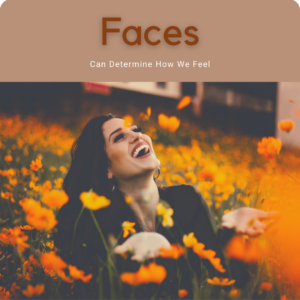 Your face reflects the emotions you feel. This is obvious: When we are sad we frown. When we are angry our eyes get smaller and everything on our faces becomes more horizontal and set. When we are happy our eyes light up and we smile. And we can instantly tell the difference between a real smile and a fake one. Did you ever wonder, or notice, what the difference actually is? In a real smile, the tiny muscles of the bottom eyelid move upward in a crescent. Before I learned this a few years ago, I couldn’t have told you what the difference was—I just knew it when I saw it. Our intuitive understanding of facial expressions is part of our empathy and ability to connect to others. Facial expression is a huge part of nonverbal communication.
Your face reflects the emotions you feel. This is obvious: When we are sad we frown. When we are angry our eyes get smaller and everything on our faces becomes more horizontal and set. When we are happy our eyes light up and we smile. And we can instantly tell the difference between a real smile and a fake one. Did you ever wonder, or notice, what the difference actually is? In a real smile, the tiny muscles of the bottom eyelid move upward in a crescent. Before I learned this a few years ago, I couldn’t have told you what the difference was—I just knew it when I saw it. Our intuitive understanding of facial expressions is part of our empathy and ability to connect to others. Facial expression is a huge part of nonverbal communication.
So we know that our faces convey how we feel. But did you know that faces can determine how we feel? Or to be more precise, changing the expression on our faces can change the emotions we experience. Since the 1980’s, researchers have found the putting a smile on makes us happier. Sales trainers have been recommending for decades that we put a smile on our faces before picking up the phone because it will make us sound happier and more likable.
More recently, researchers have found that the smile doesn’t even have to be genuine. We can “fake it till we make it”. Mori and Mori of the University of Tokyo conducted a study, published in 2009, using rubber bands and latex bandages to force participants’ cheeks upward in a smile position, or downward in a frown. In the smile position, the participants felt happier, and in the frown position, they felt sad. A follow-up study published in 2013 found that the smilers had a better opinion of others when they were smiling. Wow. We can plaster on a fake smile and not only feel happier, we’ll like people more.
And then there is the work of Amy Cuddy, a social psychologist, and researcher who investigates body language and facial expression. She presented one of the most popular TED talks ever; you can see it here. In her talk, Cuddy explains how our posture and facial expression affect our mood. She shares lots of tips on how we can use our bodies to feel more powerful and happy. One of her suggestions is to put a pencil in our mouth to force our cheeks back into a smile position in order to feel happier.
I used to love sharing this with my students when I taught at the local community college. I would sometimes ask them to put their pencils or pens between their teeth to see if they started feeling happier. Usually, they wound up laughing, probably because we all looked a little ridiculous. I have also used this knowledge to my own advantage many times. When I start to feel unhappy, I try to remember to plaster a smile on my face. Soon enough, I’m back to feeling peaceful and happy.
If you decide to test this out for yourself, I’d love to hear how it goes—leave a comment below!









